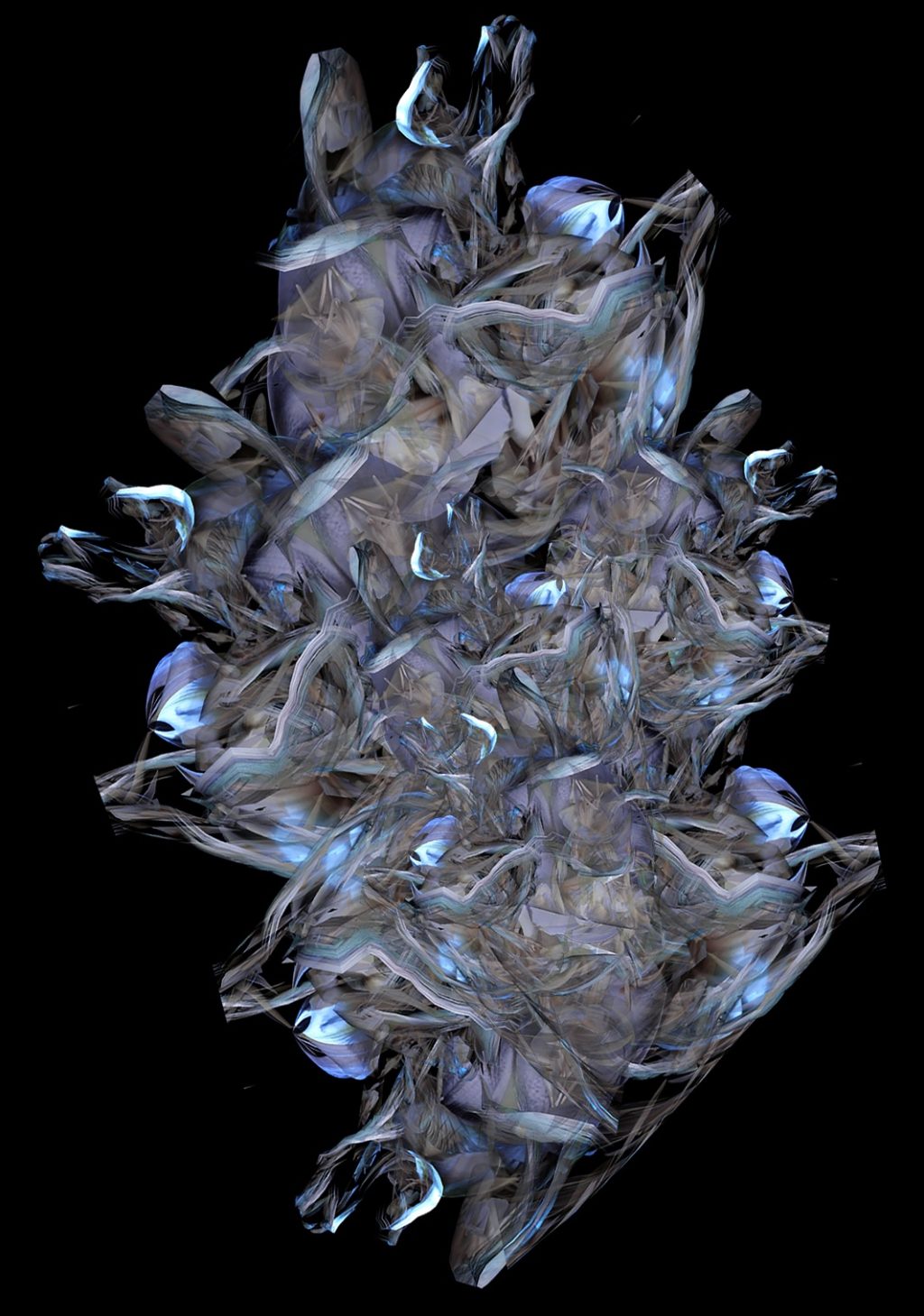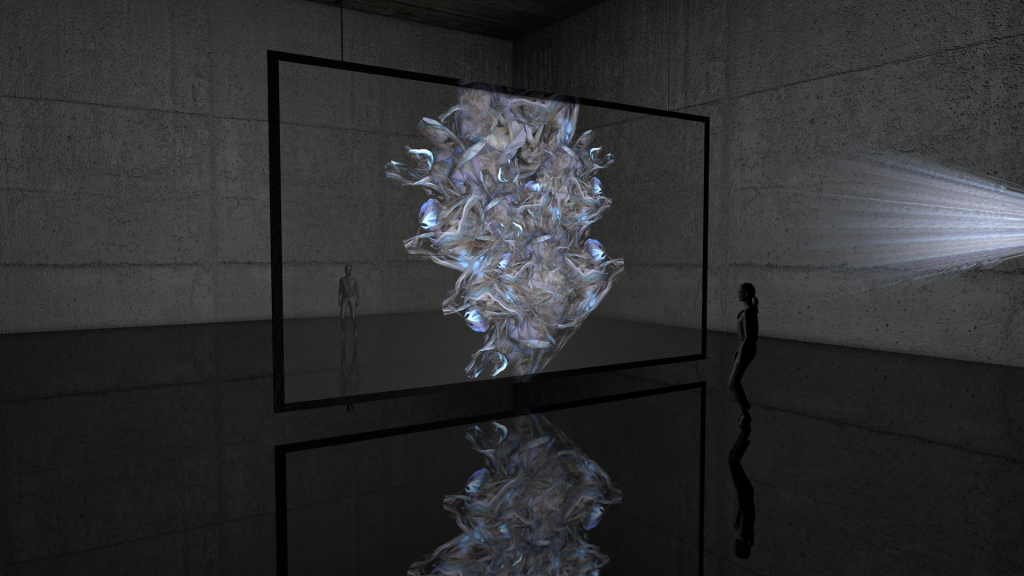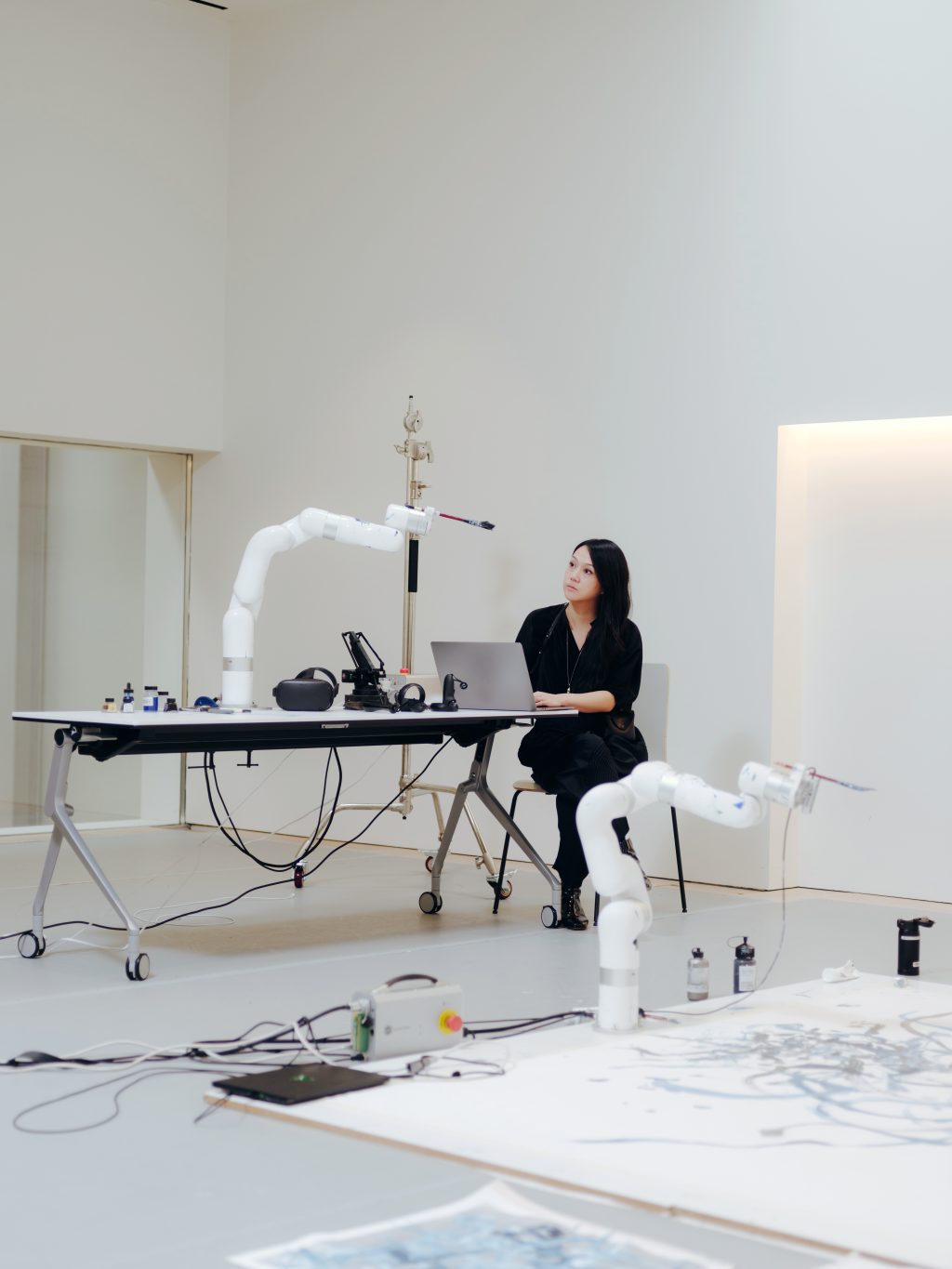A Space of Possibility
Sougwen Chung is the one who can imagine without borders. Her reference point is drawing. “It’s a ritual for me. A line is a contour of a lived experience, human figures and the organic, and when you can evolve the nature of that line, you can change your nature. Like a kind of meditative awakening, reliant on the extent of your own imagination.” This is the definition of her process. She has designed and constructed custom robots programmed with neural networks trained on her drawings gestures and biometrics. The artist and (re)searcher rejects understanding technology as a tool, but she embodies the idea of constructing robotic collaborators. The idea is challenging the technologies exploring the way in which ‘human artist’ and ‘machine artist’ can collaborate to create something extraordinary.
How did you get into art?
Sougwen Chung: My introduction to art and technology was through music and computers, in particular violin and the early internet. The expressive abstract form of sound and instrumentation through being a classically trained musician, the generative beauty of music theory, and the structure of code and screen-based work made a lot of sense to my brain. In the sense that, they all felt interrelated and correlating.
In this way my sciences and art interests have always been entangled. My mother was a programmer and my father an opera singer, so I grew up with computers and music and felt a natural affinity towards both. I’ve always felt an affinity with the duality of these pedagogies and ways of thinking, to consider the hybridity of these practices in collaboration.
The moment when I felt they could work together was the first time I drew with my first robot, D.O.U.G._1.
“At the moment, there is an urgency to hope, a revolutionary energy to it. I think hope in times past has been associated with feeling, but the times we live in are reframing hope as radical action.“
– Sougwen Chung
How do you define your aesthetic?
Sougwen Chung: I don’t! At least, I try to approach aesthetics instinctively, not try to think too much about consistency, which can become a bit limiting. There’s something rare about being able to take your own time, find your own resonances, quirks, and curiosities, and then savouring, expressing, and celebrating them. Definitions are meant to be challenged, anyhow!
Which practices lead you to this work? How important is it to be interdisciplinary today?
Sougwen Chung: Drawing, for me, as an artist and researcher, is how this all began. It’s a ritual for me. A line is a contour of a lived experience, human figures and the organic, and when you can evolve the nature of that line, you can change your nature. Like a kind of meditative awakening, reliant on the extent of your own imagination.
I’m very interested in creating and extending these lines, and meaning of making metaphors, into our processes for art-making by using technology in new ways – whether it be virtual reality, robotics or AI. I believe we can anthropomorphize our relationship with machines, particularly with robotics.
I think by broadening our conversation on how we interact with the tools of today, technology and new applications, we can start to reveal new worlds of potentiality. And by doing this with an ethic of endorsing more caring, communicative, and attentive systems we can create new collaborative and interdisciplinary approaches for ourselves and our interactions with other pedagogies, forms of thinking, and even non-human others.
“I try to approach aesthetics instinctively, not try to think too much about consistency, which can become a bit limiting.“
– Sougwen Chung
How did you start incorporating AI tools into your artistic practice?
Sougwen Chung: I really got to explore the collaboration of art with machines as a fellow for MIT’s Media Lab, discussing the hybridities of artistic mediums with technological systems. As an artist-in-residence with Nokia Bell Labs, I got to evolve the thematics of human-robotic collaboration, speculating on how the role of connected machines are expanding in scale and scope through advances in artificial intelligence and the proliferation of mechanical agencies. These speculations continue to drive my curiosity about collaborating with machines and further developing my practice alongside the expanding field of technological complexities.
I work with neural networks, computer vision, biosensors, and AR/VR to create relational robotics and technologies. You can think of them as co-creative systems interacting with my body, movements, and biology.
I like challenging the idea of the technologies I work with as being simply tools and prefer instead to nuance those in thinking of them as collaborations. This is how, over time, the expression of this research has produced a cacophony of artefacts like painting, sculpture, performances, installations and simulations.


Your practice involves performance, installation, and drawings, as well as developing pioneering technologies in robotics. What is the interaction between art and technology from your point of view?
Sougwen Chung: I think often of this quote by writer Edouard Glissant, “Science transforms its languages; poetry invents its tongues. For neither is it a question of exploring, but one, rather, of going toward a totality that is unrealizable, without being required to say where they will come together-nor even that they have any need to do so.”
Not only can artists create new forms of knowledge by engaging deeply with the technologies that shape our world, more importantly technological development must be informed by socio-historical perspectives imbued in art practice.
Tell us about the importance of “freedom of self-expression” and the sense of it in your works.
Sougwen Chung: There is a simple provocation championed by the Gutai collective – a post-war art movement from Japan that sticks in my mind. In a series of installations and radical performances, it asked participants to “Please Draw Freely”. I’ve often thought that drawing isn’t the form, it’s the way of seeing the form. And by drawing freely, one can enact a vital ritual that is an ongoing act of freedom.
What inspires you the most?
Sougwen Chung: I find a blank canvas inspiring – it’s a space of possibility.

Do you have a milestone in your life where you really felt you are an artist?
Sougwen Chung: Over the years I have been really inspired by the vast international network of artists and scientists I’ve been able to collaborate with, and whom I frequently speak with on scientific topics, creativity, or literature.
I think being in the company of those you idolise and can prophesize with, in a way, confirms I’m along the trajectory I need to be whether that’s as an artist, researcher or a yet to be defined label.
Now that we’re doing a lot of performances internationally, I’ve established my studio Scilicet in London and we’re building out various new collaborations. It’s an exciting time which sets course toward a larger milestone of creating more companion networks for the research and breadth of collaboration to continue.
What topics do you like to focus on right now?
Sougwen Chung: Lately, I’ve been interested in exploring meditation and time through biofeedback systems, regenerative and symbiotic ecologies that emerge from technological stewardship as a way to engage with this idea of the earth as itself an organism, a process of growth, rupture and flow.
“I like challenging the idea of the technologies I work with as being simply tools, and prefer instead to nuance those in thinking of them as collaborations. This is how, over time, the expression of this research has produced a cacophony of artefacts like painting, sculpture, performances, installations and simulations.“
– Sougwen Chung
What is next for you? Do you have a big dream?
Sougwen Chung: We’ve been invited to MUTEK.JP in Tokyo this year, where we will be presenting the world premiere of Flora Rearing Agricultural Network or F.R.A.N for short.
F.R.A.N. explores plant and machine co-naturality and biomimetic robotics, and was seeded during isolation. It’s been in development for the last few years and we’re excited to give it liveness since iterations of the film and installation have been presented at Pearl Art Museum Shanghai, SØRLANDETS Kunstmuseet Kristiansand, Honor Fraser Gallery Los Angeles, and Vancouver Art Gallery.
At the moment I’m building my studio Scilicet, and we’re working with a growing team of exciting collaborators on a number of projects. My first art publication is also coming out in a few months from now, a project developed in close collaboration with Montréal-based publisher Anteism Books.
A big dream? It’s honestly been a dream so far to explore these processes and provocations through practice. A dream would be a a continued intertwining of art and life – a collective space in which research and art practice, technological development and philosophical inquiry can coexist alongside inventions of new ritual and commitment to care. That’s the big dream right now.
What does hope mean to you?
Sougwen Chung: This is a beautiful question. At the moment, there is an urgency to hope, a revolutionary energy to it. I think hope in times past has been associated with feeling, but the times we live in are reframing hope as radical action.